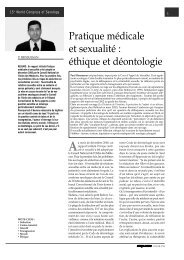Événements de vie et anxiété chez les hommes souffrant de ...
Événements de vie et anxiété chez les hommes souffrant de ...
Événements de vie et anxiété chez les hommes souffrant de ...
Create successful ePaper yourself
Turn your PDF publications into a flip-book with our unique Google optimized e-Paper software.
CLINICAL SEXOLOGY<br />
M. VINCENT ;<br />
M. BONIERBALE ; R. PORTO ;<br />
M.H. COLSON ; C. LANÇON<br />
SUMMARY : The aim of this research was to<br />
study the role of an individual’s recent<br />
experience in the ons<strong>et</strong> of erection disor<strong>de</strong>rs.<br />
Our hypothesis was that the subjects were<br />
more vulnerable to anxi<strong>et</strong>y causing<br />
difficulties for them in adapting to outsi<strong>de</strong><br />
events.<br />
Our sample was a group of 26 patients<br />
suffering from secondary erection disor<strong>de</strong>rs<br />
and a group of 20 control subjects. We used<br />
the Life-Events Questionnaire <strong>de</strong>veloped by<br />
F. Amiel-Lebigre (1986) to make a list of<br />
events experienced during the five years prior<br />
to the ons<strong>et</strong> of erection disor<strong>de</strong>rs for the<br />
patients, and during the five years prior to the<br />
date at which the questionnaire was filled in<br />
for the control subjects. The subjects were<br />
all asked to give a score b<strong>et</strong>ween 0 and 100<br />
to each event according to its emotional<br />
impact on them. We also measured the<br />
subjects’ anxi<strong>et</strong>y scores using the State-Trait<br />
Anxi<strong>et</strong>y Inventory or STAI (Spielberger, 1983).<br />
Our hypothesis was to use the State-Trait<br />
score to reflect long-standing anxi<strong>et</strong>y specific<br />
to each subject.<br />
The results show that there had been a much<br />
greater number of life events during the year<br />
prior to the ons<strong>et</strong> of erection disor<strong>de</strong>rs for the<br />
patients than for the control subjects. A<br />
<strong>de</strong>tailed analysis of this peak of events<br />
revealed that the most common events were<br />
those of an emotional nature and those<br />
involving a loss, or bereavement. We also<br />
noted that the patients often assigned a high<br />
emotional impact score to this type of event.<br />
In addition, the results did not show any<br />
higher state-anxi<strong>et</strong>y and/or trait-anxi<strong>et</strong>y<br />
scores for patients than for control subjects.<br />
KEY WORDS:<br />
• Erection disor<strong>de</strong>rs<br />
• Life-events<br />
• Anxi<strong>et</strong>y<br />
VINCENT M. <strong>et</strong> al. (2004) Europ. J. of Sexol ; Sexologies ; (XIII), 48 : 11-12<br />
Life events<br />
and anxi<strong>et</strong>y in male<br />
subjects suffering<br />
from erectile<br />
disor<strong>de</strong>rs<br />
How important are life events<br />
recently experienced by individuals<br />
in the ons<strong>et</strong> of erection<br />
disor<strong>de</strong>rs? We also investigate the<br />
role of anxi<strong>et</strong>y as a factor that could<br />
not only potentially reduce the individual’s<br />
capacity to cope with outsi<strong>de</strong><br />
events, but also with regard to the performance<br />
anxi<strong>et</strong>y mo<strong>de</strong>l first <strong>de</strong>scribed<br />
by Masters and Johnson (1971)<br />
and often used since in contemporary<br />
mo<strong>de</strong>ls.<br />
Life events<br />
A specific m<strong>et</strong>hodology has been<br />
<strong>de</strong>veloped to study the effect of life<br />
events on an individual’s experience.<br />
The lea<strong>de</strong>rs on the subject of life-event<br />
m<strong>et</strong>hodology are Holmes and Rahe.<br />
In 1967 they <strong>de</strong>veloped the Schedule<br />
of Recent Experience, the very first<br />
questionnaire on life events to be validated.<br />
In the past thirty years, a complex<br />
approach has <strong>de</strong>veloped to the<br />
relationship b<strong>et</strong>ween events and<br />
disease, leading to the appearance of<br />
various different event questionnaires.<br />
Questionnaires as a clinical tool have<br />
enabled the long-suspected role of the<br />
emotional impact of life events on the<br />
ons<strong>et</strong> or <strong>de</strong>terioration of somatic or<br />
psychological disor<strong>de</strong>rs to be clearly<br />
evi<strong>de</strong>nced.<br />
Aharonian <strong>et</strong> coll. (1991) applied the<br />
event-based m<strong>et</strong>hodology to erectile<br />
disor<strong>de</strong>rs. According to the results they<br />
obtained, there would appear to be<br />
two <strong>de</strong>cisive factors: the concept of a<br />
quantitative accumulation of highimpact<br />
events during a brief lapse of<br />
time, and the main type of events<br />
taking place during this lapse of time.<br />
This led us to formulate the following<br />
hypotheses:<br />
H1: Men suffering from an erection<br />
disor<strong>de</strong>r have experienced a significantly<br />
higher number of high-impact<br />
life events during the year before the<br />
ons<strong>et</strong> of the disor<strong>de</strong>r.<br />
H2: There might be a type of event that<br />
is conducive to the ons<strong>et</strong> of erection<br />
disor<strong>de</strong>rs, i.e. emotional events or<br />
events related to a loss.<br />
■ M<strong>et</strong>hodology<br />
The sample comprises a “patient”<br />
group including 26 subjects who<br />
consulted for a secondary erection<br />
disor<strong>de</strong>r, and a control group of 20<br />
subjects.<br />
Using the Life-events questionnaire<br />
<strong>de</strong>veloped by F. Amiel-Lebigre (1986),<br />
we listed the events experienced by<br />
the subjects during the five years prior<br />
to the ons<strong>et</strong> of their erection disor<strong>de</strong>r<br />
(t0) for the patients, and during the five<br />
years prior to the date at which the<br />
questionnaire was being filled in (t0)<br />
for the control subjects. The events<br />
experienced are i<strong>de</strong>ntified by means<br />
of the date of ons<strong>et</strong> (year), the area<br />
they concern (professional, financial,<br />
social, emotional, family and health),<br />
their type (gain or loss), and an impact<br />
score given by the subjects themselves<br />
on a scale of 0 to 100 (with 100<br />
being the maximum impact).<br />
- VOL.XIII, N°49<br />
11




